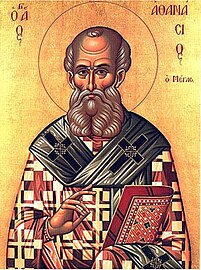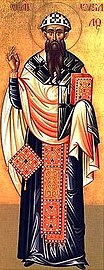January 17 - Eastern Orthodox liturgical calendar - January 19

All fixed commemorations below are observed on January 31 by Eastern Orthodox Churches on the Old Calendar.[note 1]
For January 18th, Orthodox Churches on the Old Calendar commemorate the Saints listed on January 5.
Saints
- Martyr Theodula of Anazarbus in Cilicia (c. 304)[1][2]
- Martyrs Helladius, Theodoulos, Boethius, Evagrius, and Macarius, of Anazarbus in Cilicia (c. 304)[1][3]
- Martyr Xenia, by fire.[4]
- Saint Athanasius the Great, Archbishop of Alexandria (373)[1][5][6]
- Venerable Marcian of Cyrrhus, monk, in Syria (c. 388)[1][7][8]
- Saint Cyril of Alexandria, Archbishop of Alexandria (444)[1][9][10]
- Venerable Ephraimios, Bishop of Mylasa, in Caria (5th century)[11][12][note 2]
- Venerable Sylvanus of Palestine, the ascetic.[13]
Pre-Schism Western saints
- Virgin-martyr Prisca, venerated from ancient times in Rome, where a church is dedicated to her on the Aventine (1st or 3rd century)[14]
- Martyrs Archelais, Thecla and Susanna, three holy virgins, at Salerno (293)[14][note 3] (see also: June 6)
- Saint Volusianus of Tours, a married senator who was chosen Bishop of Tours in France and shortly after driven out by Arian Visigoths (496)[14]
- Saint Liberata of Como, a holy virgin in Como in Italy where with her sister St Faustina she founded the convent of Santa Margarita (580)[14]
- Saint Leobardus of Marmoutier in Gaul, hermit (593)[1][14]
- Saint Ninnidh of Inismacsaint, Ireland (6th century)[1] (see also: January 17)
- Saint Deicolus, one of the twelve disciples to accompany St. Columbanus in his missionary enterprise (625)[14][note 4]
- Saint Ulfrid (Wolfred, Wulfrid, Wilfrid), missionary in Germany and Sweden, martyred for destroying an image of Thor (1028)[12][14][note 5][note 6]
Post-Schism Orthodox saints
- Venerable Ephraim the Lesser (the Philosopher) of Georgia (1101)[1][17]
- Venerable Cyril, Igumen at Kiev (1146)[1]
- Saint Joachim, Patriarch of Turnovo (1248)[1][18]
- Saints Cyril, Schemamonk, and Maria, Schemanun (both c. 1337), parents of St. Sergius of Radonezh.[1][19]
- Saint Maximus of Serbia, Archbishop of Wallachia (1516)[1][20][21]
- Venerable Athanasius of Syandemsk, Abbot of Syandemsk (Valaam and Vologda) (1550)[1][22][23]
- Venerable Athanasius of Navolotsk, Fool-for-Christ (16th-17th centuries)[1][24][25]
- Saint Alexis (Shushania), Hieromonk of Teklati, Georgia (1923)[1][26]
New martyrs and confessors
Icon gallery
- Saint Athanasius the Great.
- Saint Cyril of Alexandria.
- Saints Athanasius and Cyril of Alexandria
(Menologion of Basil II) - Virgin-martyr Prisca.
Notes
- The notation Old Style or (OS) is sometimes used to indicate a date in the Julian Calendar (which is used by churches on the "Old Calendar").
The notation New Style or (NS), indicates a date in the Revised Julian calendar (which is used by churches on the "New Calendar"). - Venerable Ephraimios is recorded in Sinai Codex 150.
- Three holy virgins of the Romagna in Italy who went to Nola in the Campagna in order to escape death, but there too they were accused of being Orthodox, were tortured, taken to Salerno and beheaded.
- A monk at Bangor in Ireland, he followed St Columbanus to Burgundy in France, where he helped found the monastery of Luxeuil. Later he founded a second monastery in Lure in the Vosges.
- "He was an Englishman of great learning and virtue; and preached the faith, first in Germany; afterwards in Sweden, under the pious king Olas II, who first took the title of king of Sweden; for his predecessors had only been styled kings of Upsal. The good bishop converted many to Christ, till in the year 1028, while he was preaching against the idol Tarstans or Thor, and hewing it down with a hatchet, he was slain by the pagans."[15]
- "In Sweden, the passion of ST. ULFRID, Martyr, who was an Englishman by birth, and went to preach to the pagans of that country. ULFRID, also called Wulfrid, was an Englishman, who, in obedience to a divine inspiration, quitted his native land, to preach the Gospel to the pagans of Sweden. His mission was attended with ample success, and many converts were made to the Faith. In his zeal for the destruction of the kingdom of Satan, in the presence of a multitude of people, he attacked the idol of Thor, and hewed it to pieces with an axe. Upon this, the furious idolaters immediately rushed upon the servant of God, and cruelly put him to death on the spot. They also treated his venerable remains with many insults, and cast them into a marsh, thus leaving them, until in better times Ulfrid was venerated as a Martyr of Christ. The commemoration in the old calendars is on the 18th of January."[16]
References
Sources
Wikiwand in your browser!
Seamless Wikipedia browsing. On steroids.
Every time you click a link to Wikipedia, Wiktionary or Wikiquote in your browser's search results, it will show the modern Wikiwand interface.
Wikiwand extension is a five stars, simple, with minimum permission required to keep your browsing private, safe and transparent.




